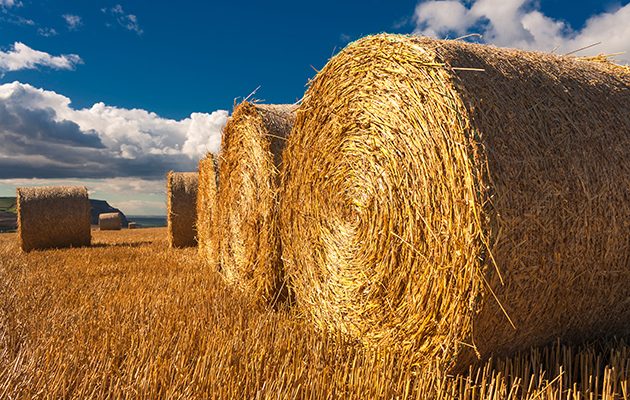Once an inconvenient by-product, demand for straw is rising fast as it is used for everything from animal fodder to fuel. Could its worth outstrip that of grain, wonders Tim Field
Straw used to be an inconvenient by-product, but now demand is rising as it is used for everything from animal fodder to fuel, says Tim Field.
For more on farming, read about the conservation farmers restoring wildlife on their land making a powerful case for Government funding in exchange for public benefits post Brexit.
RISING DEMAND FOR STRAW
Creeping up a field margin is my idea of an evening well spent. Eyes peeled for two ears poking above the corn. Once the dock-leaf imposters have been ruled out, the glasses go up to spy between the ears, hoping for a set of antlers for the stalk to continue. As summer turns to autumn the combine harvester passes by and with it goes the roe buck rut. The stage is set to venture out with decoys, build a hide from a few bales and ambush the woodies as their banquet of chaff and grain spoils is revealed.
Whether standing or baled, in the field, the pen or the stable, straw is a welcome accessory for the field sportsman – certainly valued more highly than by the rushing commuter or tardy school-mum stuck behind yet another bale-carting tractor-trailer. This year more than ever, farms are also appreciating the value of straw. In July, record prices were reported with a standing acre yielding £200 in straw alone.
Historically, conflicts for straw supplies would have been between building and thatching material, animal fodder and bedding. With more mixed farms in the past, the latter would ordinarily be generated on-farm and markets more localised. However, with modern agriculture seeing a national split – with arable dominating the eastern counties and livestock to the west – and increasing demand from other markets, the price and supply of straw has become highly volatile for farmers.
Today, we see additional conflicts for straw. In a bid to increase soil organic matter where livestock is absent, there is an argument for chopping the harvested straw and returning it back to the soil. This would certainly be a favourable option if wet weather persisted during the baling-time window. There are other benefits to chopping straw, from reduced handling effort, carting and thus less issues of soil compaction. However, those who do manage to bale their straw now have a healthy demand from biofuel power plants, which are hungry for any surplus. Sadly, those in fixed contracts with the power plants won’t see the benefits of the current rocketing prices, yet they contribute to the overall increased demand and financial pain for those livestock farms looking to buy.
THE NEW PLASTIC
With plastic disparaged by consumers, and biodegradable and natural materials favoured, there are interesting innovations in packaging. Straw can now find its way into a variety of plant-based materials and as global chains such as McDonald’s and Starbucks yield to pressure and ban plastic straws, perhaps it won’t be long before they follow our recent steps to introduce rustic but functional wheat drinking straws.
Expansion into new markets will have helped accelerate demand and consequential price rises but ultimately the past 18 months have seen the perfect storm of equally short supply. The dry spring in 2017 led to poor development, followed by a wet harvest that restricted ability to bale, followed by a prolonged winter putting huge demand on dwindling supplies, followed by 2018’s summer drought that will no doubt leave us short again. Many farms will have prayed for decent harvest conditions to break this cycle, otherwise more heads will be turning to bedding alternatives, such as the poorer grass crops, waste paper, recycled wood shavings or sawdust.
Reflecting on the primary purpose of straw – a stem upon which the grain grows, ripens away from pests and disease, and presents for harvest – the failure to perform this essential role can also spell misery. A field of flattened corn is a sorry sight and this “lodging” can result in a yield dip of up to 75%. There are numerous causes of lodging, from excessive fertiliser application to disease, but, ultimately, top-heavy, high-yielding varieties combined with adverse weather and soil conditions are the principle contributors to a crop’s downfall. In a bid to overcome the risk of lodging, plant growth regulators are applied, or varieties bred to have shorter straw length. It is yet another factor contributing to the rising value of a bail. With farmers in spring joking that a tonne of straw will be more expensive than a tonne of wheat, straw is now seldom seen as an inconvenient by-product.
Follow Tim and Agricology, @agricology





